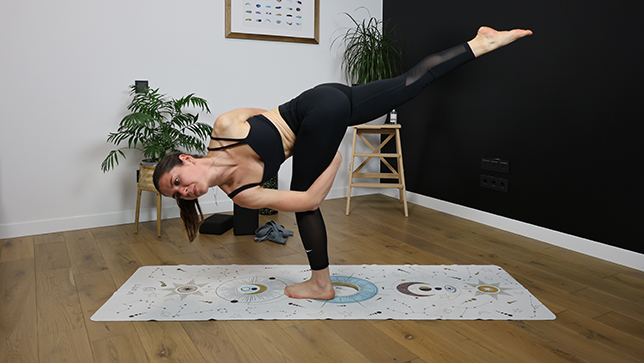Bound Half Moon Twist - Baddha Parivrtta

Contents
Bound Half Moon Twist Pose is generally known as Baddha Parivrtta Ardha Chandrasana. The Word Baddha parivrtta Ardha Chandrasana is originated from Sanskrit Word. In, which Baddha – Locked, bound, Parivrtta – Revolved, twist, Ardha – Half, Chandra – Moon and Asana – pose.
Bound Revolved Half Moon Twist Pose helps to stimulate the solar Plexus, Manipura Chakra; this chakra is connected with personal power as well as self – esteem also.
Baddha Parivritta Ardha Chandrasana is a standing yoga pose that combines the benefits of balancing, twisting, and stretching. It is an intermediate-level pose that requires focus, strength, and flexibility.
Pose Detail
- Difficulty: Advanced, Intermediate
- By Type: Balancing Yoga Poses, Flexibility Yoga Poses, Shoulder Opening Yoga Poses, Strengthening Yoga Poses
- Body Position: Forward Bend Yoga Poses, Standing Yoga Poses, Twist Yoga Poses
Step-by-Step Instructions
Benefits and Contraindications
Stimulates the digestive system and detoxifies the body
Improves balance and stability
Strengthens the legs, core, and hips
Stretches the spine and shoulders
Calms the mind and relieves stress and anxiety
Low or high blood pressure
Neck pain
Pregnancy the second and third trimesters
Headache
Modifications and Props for Beginners
- If you have trouble balancing in this pose, use a block to support your bottom hand. Place the block on the mat directly under your shoulder and adjust the height of the block as needed. This will help you to feel more stable and grounded.
- If you have trouble balancing, use a wall for support. Stand with your back to the wall and place your bottom hand on the wall. This will help you to stabilize your balance and prevent you from falling over.
- If you cannot straighten your bottom leg, bend it slightly or place your foot on a block. You can also keep your top foot on the floor instead of lifting it up. Focus on maintaining the twist and lengthening your spine, rather than worrying about the position of your legs.
Useful Tips
- Start with a strong foundation by rooting down through your standing foot and engaging your core.
- Focus on lengthening your spine and keeping your chest open.
Use your breath to deepen the twist and create space in your body. - Don’t force yourself into the pose – only go as far as feels comfortable for your body.
- Practice regularly to build strength and flexibility in your body.
Frequently Asked Questions
Some common mistakes to avoid when practicing Bound Half Moon Twist include collapsing the chest or rounding the back, letting the knee of the standing leg bend too much, and not engaging the core or the leg muscles enough. It’s also important to avoid forcing the pose and to listen to your body to avoid injury.
It’s always best to check with your healthcare provider before practicing yoga during pregnancy. Bound Half Moon Twist can be practiced during the first trimester, but it’s usually advised to avoid deep twists during the second and third trimesters.
Bound Half Moon Twist is an intermediate to advanced level yoga pose that requires strength, balance, and flexibility. It is recommended for experienced practitioners, but beginners can work up to it with the help of a qualified yoga teacher.
It can be challenging for beginners or people with balance or mobility issues.
People with low blood pressure, vertigo, or neck or shoulder injuries should be cautious or avoid this pose.
Always listen to your body and modify or skip the pose if it causes pain or discomfort.
Variations
- Half Moon Pose
- Revolved Half Moon Pose
- Sugarcane Pose
- Bound Half Moon Twist Pose With A Block
- Bound Half Moon Twist Pose Next To The Wall